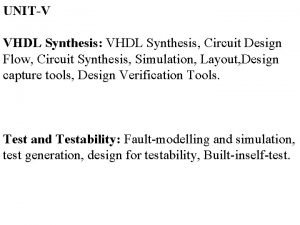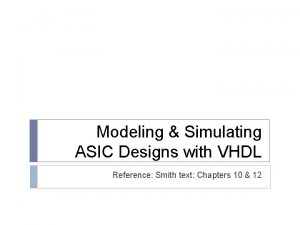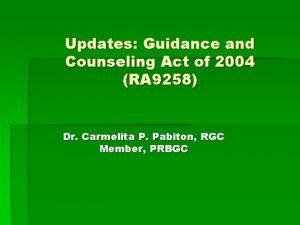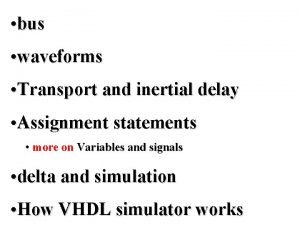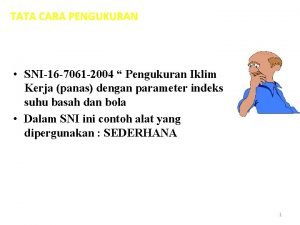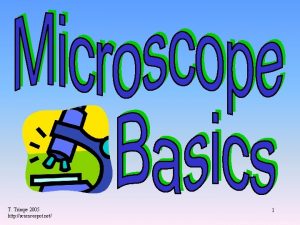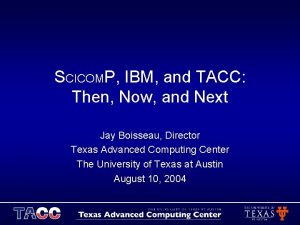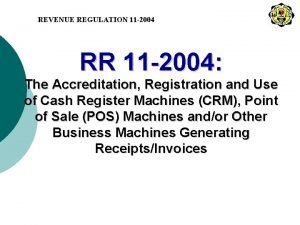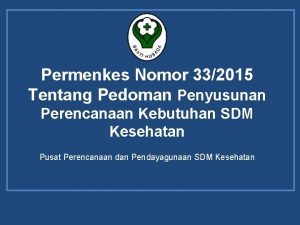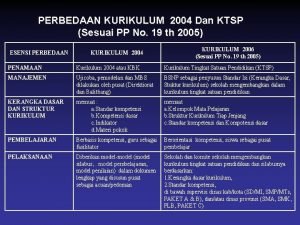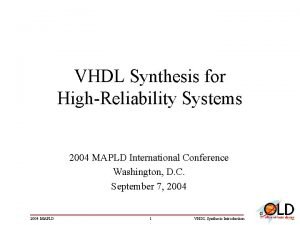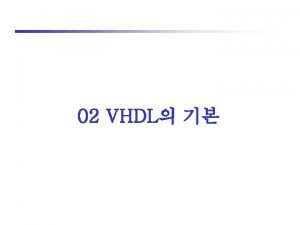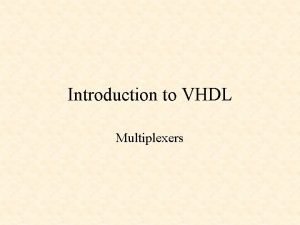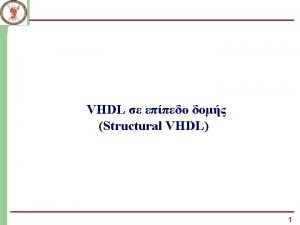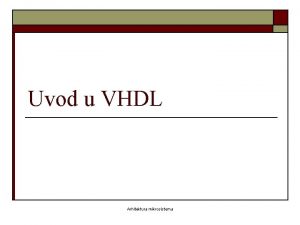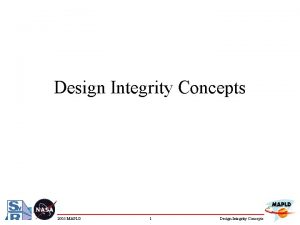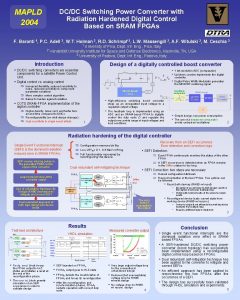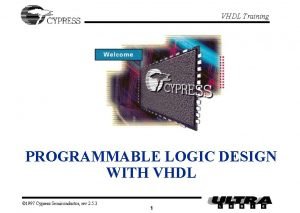VHDL Design Review And Presentation 2004 MAPLD VHDL






































- Slides: 38

VHDL Design Review And Presentation 2004 MAPLD VHDL Design Review

Designer’s Responsibilities (Besides Doing the Design): • Make the design reviewable and transferable – Documentation • Theory of operation • Proof that spec and WCA are met – Organization • Partitioning into logical components – Presentation • Readability of schematics, VHDL, etc. • Inadequate documentation biggest design review problem – How would you, the designer, explain your design to someone else? • Reviewer’s question: If the designer can’t present the design, does the designer understand the design? 2004 MAPLD 2 VHDL Design Review

How to Review VHDL Designs • How does one perform a design review, in general? – Most design review tasks are independent of how the design is presented • What does VHDL add to the task? 2004 MAPLD 3 VHDL Design Review

What VHDL Adds to the Review Process • Probably, an awful lot more work!! • VHDL introduces serious problems: – It hides design details – It is not WYSIWYG: What you see (as your design concept in VHDL) may not be what you get (as an output of the synthesizer) – Coupled with FPGAs, it encourages bad design practices • Understanding design by reading code extremely difficult 2004 MAPLD 4 VHDL Design Review

VHDL Hides Design Details • Connectivity hard to follow in VHDL files • Behavior of sequential circuits can be hard to follow through processes • Interactions between modules can be difficult to understand • Spelling errors → undetected circuit errors 2004 MAPLD 5 VHDL Design Review

Following connectivity • Signal name changes make task difficult • My method as a reviewer: – Import modules into Libero – Create symbols for modules – Create a schematic with modules and print it out on E-size paper – Connect modules with colored pencils • Designer should do this as part of design presentation 2004 MAPLD 6 VHDL Design Review

Following Connectivity Simple Input and Output Example MA 1: COUNT 23 port map (RST_N => SIM_CLR_N, SYNC_CLR => EQUALS_internal, CLOCK => C 5 MHZ, Q => TIME_NOW_internal ); MA 3: MUX_23_4 port map (A => R 1 HZ, B => R 6 HZ, C => R 8 HZ, D => R 10 HZ, T => THZ, T_SEL => TEST_SEQ, S 1 => RATE_SEL(1), S 0 => RATE_SEL(0), Y => Y ); MA 2: COMP 23 port map (DATAA => TIME_NOW_internal, DATAB=> Y, AEB => EQUALS_internal ); MA 7: GATE_RANGE port map (RST_N => RST_N, CLOCK => C 5 MHZ, OPEN_VALUE => OPEN_VALUE, CLOSE_VALUE => CLOSE_VALUE, TIME_NOW => TIME_NOW_internal, GATE => GATE ); MA 8: BIN 2 GRAY 23 port map (A => TIME_NOW_internal, Y => GRAYTIME ); Note: Had to print out the entity just to make this slide. EQUALS <= EQUALS_internal; TIME_NOW <= TIME_NOW_internal; end RTL_ARCH; 2004 MAPLD Inputs Outputs 7 VHDL Design Review

Following Connectivity Signals In a Simple Module MA 1: COUNT 23 port map (RST_N => SIM_CLR_N, SYNC_CLR => EQUALS_internal, CLOCK => C 5 MHZ, Q => TIME_NOW_internal ); MA 3: MUX_23_4 port map (A => R 1 HZ, B => R 6 HZ, C => R 8 HZ, D => R 10 HZ, T => THZ, T_SEL => TEST_SEQ, S 1 => RATE_SEL(1), S 0 => RATE_SEL(0), Y => Y ); MA 2: COMP 23 port map (DATAA => TIME_NOW_internal, DATAB=> Y, AEB => EQUALS_internal ); MA 7: GATE_RANGE port map (RST_N => RST_N, CLOCK => C 5 MHZ, OPEN_VALUE => OPEN_VALUE, CLOSE_VALUE => CLOSE_VALUE, TIME_NOW => TIME_NOW_internal, GATE => GATE ); MA 8: BIN 2 GRAY 23 port map (A => TIME_NOW_internal, Y => GRAYTIME ); Making this chart was a lot of work and was error prone. EQUALS <= EQUALS_internal; TIME_NOW <= TIME_NOW_internal; end RTL_ARCH; 2004 MAPLD 8 VHDL Design Review

E. g. , A Spelling Error? • A VHDL module contained two signals: – CSEN appeared only on the left side of a replacement statement: CSEN <= … – CS_EN sourced several signals, i. e. , appeared on the right side X <= CS_EN… • Were they intended to be the same signal? 2004 MAPLD 9 VHDL Design Review

E. g. , Meaning of Names -- ADDRESS DECODE LOGIC VALUES IF (ADDRCOUNT >= "000001000") THEN ADCGE 8_I <= '1'; [note name ends in “ 8” and comparison value is 8] ELSE ADCGE 8_I <= '0'; END IF; IF (ADDRCOUNT >= "000000110") THEN ADCGE 6_I <= '1'; [note name ends in “ 6” and comparison value is 6] ELSE ADCGE 6_I <= '0'; END IF; IF (ADDRCOUNT = "000110101" OR LOADAC = '1') THEN ADCGE 36_D <= '1'; [note name ends in “ 36” but comparison value is 35] • Lesson: Be careful with your names! 2004 MAPLD 10 VHDL Design Review

VHDL is Not WYSIWYG • Signals intended to be combinational can end up being sequential, and vice versa • Sequential circuits can have unexpected, undesirable SEU behavior – Paper: “Logic Design Pathology and Space Flight Electronics”, R. Katz, R. Barto, K. Erickson, 2000 MAPLD International Conference • The designer gives up some control over the design to unvalidated software 2004 MAPLD 11 VHDL Design Review

VHDL and Bad Design Practices • VHDL and FPGAs combine to allow designers to treat design as software – Especially for FPGAs for which there is no reprogramming penalty, e. g. , Xilinx • Rather than designing by analysis, designers simply “try” design concepts 2004 MAPLD 12 VHDL Design Review

E. g. , part of a 16 page process -- V 1. 02 & V 2. 2 -- DATA WILL STOP TANSFERING IFF BOTH HOLD AND OUTPUT ENABEL ARE -- ACTIVE FOR THE SAME PORT ----- HOLD 2 <= ((((HLD 2 TX_N_Q AND O_EN_Q(2)) OR (HLDTX_N_Q AND O_EN_Q(1)) OR (ROFRDY_N_Q AND O_EN_Q(0))) AND NOT(BYPASS_EN_Q AND (HLDTX_N_Q AND O_EN_Q(1))))); HOLD 1_I <= ((HLDTX_N_Q O_EN_Q(0))); -- V 2. 2 AND O_EN_Q(1)) OR (ROFRDY_N_Q AND HOLD 2 <= (((((HLD 2 TX_N_Q AND O_EN_Q(2)) OR (HLDTX_N_Q AND O_EN_Q(1)) OR (ROFRDY_N_Q AND O_EN_Q(0))) AND NOT(BYPASS_EN_Q AND (HLDTX_N_Q AND O_EN_Q(1))))) OR (((HLD 2 TX_N_Q AND O_EN_Q(2)) OR (HLDTX_N_Q AND O_EN_Q(1))) AND (BYPASS_EN_Q AND HLDTX_N_Q AND O_EN_Q(1)))); 2004 MAPLD 13 VHDL Design Review

Simplifying Let: a=HDL 2 TX_N_Q and O_EN_Q(2) b=HLDTX_N_Q and O_EN_Q(1) c=ROFRDY_N_Q and O_EN_Q(0) d=BYPASS_EN_Q Then HOLD 2=(a+b+c)·(d·b)’ + (a+b)·(d·b) = a+b+c. What happened to d=BYPASS_EN_Q? ? 2004 MAPLD 14 VHDL Design Review

Lessons • Don’t just try things, think about what you’re doing – Either BYPASS_EN_Q is needed or it’s not – what’s the requirement of the system? • Make modules small enough to test via VHDL simulation, and test them fully. – If this logic was tested by itself, the error would have been found. • It’s on orbit, now 2004 MAPLD 15 VHDL Design Review

Combined Effects of VHDL Hidden design details + Non-WYSIWYG nature + Bad design practices ÞDesigner can lose control of design i. e. , the designer loses understanding of what is in the design, then adds erroneous circuitry until simulation looks right 2004 MAPLD 16 VHDL Design Review

E. g. , found in a VHDL file: CASE BVALREG 3 A_Q IS WHEN "0000" => IF (DAVAIL_LCHA_Q = '1' ) THEN -ISN'T THIS CONDITION ALWAYS TRUE -AT THIS POINT? ? ? PC • Just how well did the designers understand the design? ? 2004 MAPLD 17 VHDL Design Review

Worst Case Result • A design that works in simulation for expected conditions, but with flaws that show up in unusual conditions • Passed on with little documentation by engineers who become unavailable ÞA total programmatic disaster!! An common occurrence! 2004 MAPLD 18 VHDL Design Review

Solution to VHDL Problem • Make sure designs are reviewable and transferable – No such thing as too good an explanation of how a circuit works • Don’t use VHDL (much less Verilog!!) 2004 MAPLD 19 VHDL Design Review

VHDL Review Tools and Techniques 2004 MAPLD 20 VHDL Design Review

Netlist Viewer • Crucial because – Synthesizer output, not VHDL, is the final design – Easy to see asynchronous design items – Connectivity often more apparent in viewer than in VHDL • Helps solve the non-WYSIWYG nature of VHDL 2004 MAPLD 21 VHDL Design Review

. srr files • Flip-flop replication – See examples in “Synthesis Issues” module. • State machine encoding and illegal state protection • Inferred clocks => possible asynchronous design techniques • Resource usage 2004 MAPLD 22 VHDL Design Review

. adb files • Needed for netlist viewer • Check internal timing • Get timing parameters to perform board level timing analysis • Check I/O pin options 2004 MAPLD 23 VHDL Design Review

VHDL Simulator • Simulate modules or extract parts of modules • Try to break them: – Most simulations are success oriented, in that they try to show the module works when it gets the expected inputs – Try to simulate with the unexpected inputs – Easier to do with smaller modules 2004 MAPLD 24 VHDL Design Review

E. g. , breaking a FIFO Here’s the full flag, but we’ll keep writing Here we get the full flag while reading out Turned out to be a problem for the project 2004 MAPLD 25 VHDL Design Review

Suggestions for FPGA Design Presentation 2004 MAPLD VHDL Design Review

Goals • Detailed design review and worst-case analysis are the best tools for ensuring mission success. • The goal here is not to make more work for the designer, but to: – Enhance efficiency of reviews – Make proof of design more clear – Make design more transferable – Improve design quality 2004 MAPLD 27 VHDL Design Review

Steps to Preparing for Design Review 1. 2. 3. 4. 5. 6. 7. 8. 9. Modularize your design Make a datasheet for each module Show FPGA design in terms of modules Describe internal circuitry Describe state machines Describe FPGA connections Describe synthesis results Provide timing spec for external timing analysis Show requirements of external circuitry 2004 MAPLD 28 VHDL Design Review

1. Modularize your design • Easier to do during design phase • Goal is to describe design in terms of components that can be individually verified • Each component, or module, is a separate VHDL entity • Modules should be of moderate, e. g. , MSI, size – E. g. , FIFO, ALU – Counter, decoder probably too small – VME interface too big 2004 MAPLD 29 VHDL Design Review

2. Make a Datasheet for Each Module • • Describe the module’s behavior Show truth table Show timing diagrams of operation Provide test bench used to verify module – Try to break it • Model: MSI part data sheet 2004 MAPLD 30 VHDL Design Review

3. Show FPGA Design in Terms of Modules • Provide requirements spec for FPGA • Draw block diagram • Top-level VHDL entity shows FPGA inputs and outputs and ties component modules together • Show necessary timing diagrams – Interaction between modules – Interaction with external circuitry • Text for theory of operation • Provide test bench for top level simulation 2004 MAPLD 31 VHDL Design Review

4. Describe internal circuitry • Use of clock resources • Discuss skew issues • Describe deviations from fully synchronous design – Be prepared to show necessary analysis • Show asynchronism is handled – External signals – Between clock domains • Glitch analysis of output signals used as clocks by other parts 2004 MAPLD 32 VHDL Design Review

5. Describe state machines • • Encoding chosen Protection against lock-up states Homing sequences Reset conditions 2004 MAPLD 33 VHDL Design Review

6. Describe FPGA Connections • Use of special pins: TRST*, MODE, etc. • Power supply requirements – Levels, sequencing, etc. • • • Termination of unused clock pins Input and output options chosen for pins Discuss transition times of inputs POR operation and circuitry Critical signals and power-up conditions – Remember WIRE! (being presented next door in a parallel seminar). 2004 MAPLD 34 VHDL Design Review

7. Describe synthesis results • Percentage of utilization • Flip-flop replication and its effects on reliable operation • Margin results from Timer • Timing of circuits using both clock edges 2004 MAPLD 35 VHDL Design Review

8. Provide Timing Specification for External Timing Analysis • • t. SU, t. H with respect to clock Clock to output t. PD t. PW for signals connected to flip-flop clocks Clock symmetry requirements if both edges of clock used 2004 MAPLD 36 VHDL Design Review

9. Show Requirements of External Circuitry • Provide data sheets for parts interfacing to FPGA • Show timing diagrams of interactions of FPGA to other parts • Show timing analysis of external circuitry 2004 MAPLD 37 VHDL Design Review

References • Design guidelines: http: //klabs. org/DEI/References/design_guidelines/nasa_guidelines/ • Design tutorials http: //klabs. org/richcontent/Tutorial/tutorial. htm • Design, analysis, and test guidelines: http: //klabs. org/DEI/References/design_guidelines/design_analysis_test_guides. htm 2004 MAPLD 38 VHDL Design Review
 Design review presentation
Design review presentation Vhdl synthesis circuit design flow
Vhdl synthesis circuit design flow Vhdl design flow
Vhdl design flow Vhdl
Vhdl Vertex presentation and cephalic presentation
Vertex presentation and cephalic presentation 4 maneuvers of leopold
4 maneuvers of leopold Guidance and counseling act of 2004
Guidance and counseling act of 2004 Quarterly business review powerpoint template
Quarterly business review powerpoint template Movie review presentation
Movie review presentation Iso awareness training for employees
Iso awareness training for employees Test readiness review presentation
Test readiness review presentation Chapter review motion part a vocabulary review answer key
Chapter review motion part a vocabulary review answer key Uncontrollable spending ap gov
Uncontrollable spending ap gov Nader amin-salehi
Nader amin-salehi What is inclusion and exclusion
What is inclusion and exclusion Narrative review vs systematic review
Narrative review vs systematic review Difference between www and internet
Difference between www and internet Engineering design and presentation
Engineering design and presentation Weld mapping symbols
Weld mapping symbols Inertial delay and transport delay
Inertial delay and transport delay Forms and reports in system analysis and design
Forms and reports in system analysis and design Macrocible
Macrocible Pearson education, inc
Pearson education, inc Dgc 2004
Dgc 2004 Tabel rh
Tabel rh T. trimpe 2004 http //sciencespot.net/
T. trimpe 2004 http //sciencespot.net/ Gaatn
Gaatn 2004 dress code
2004 dress code Roles and responsibilities of grievance committee in school
Roles and responsibilities of grievance committee in school Sworn statement for esales registration
Sworn statement for esales registration Legge urbanistica regione campania 16/2004
Legge urbanistica regione campania 16/2004 Permenkes 33 tahun 2015
Permenkes 33 tahun 2015 Perbedaan kurikulum 2004 dan 2013
Perbedaan kurikulum 2004 dan 2013 2004 ford ranger 2.3 firing order
2004 ford ranger 2.3 firing order Age discrimination act 2004
Age discrimination act 2004 Ley idea 2004
Ley idea 2004 Fiona pilkington timeline
Fiona pilkington timeline Lancaster 2004
Lancaster 2004 Anti discrimination act qld
Anti discrimination act qld

